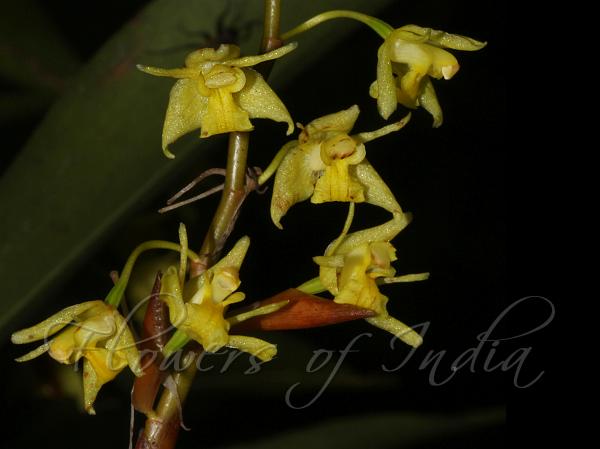|
| Prolific Coelogyne |
|

|

| File size | 407282 |
| Original date | 6/8/16 12:07 PM |
| Resolution | 2048 x 1536 |
| Flash | Flash fired |
| Focal length | 135.0mm |
| Exposure time | 1/200s |
| Aperture | 32.0 |
| Focus Distance | 0.38m |
| Metering Mode | Multi-segment |
| Camera make | Canon |
| Camera model | Canon EOS REBEL T4i |
| Sensor type |
|
|
|
|
Photo: |
Botanical name: Coelogyne prolifera Family: Orchidaceae (Orchid family)
Synonyms: Coelogyne flavida, Pleione flavida, Pleione prolifera
Synonyms: Coelogyne flavida, Pleione flavida, Pleione prolifera
Prolific Coelogyne is an orchid found on tree
trunks and lower branches as a small to medium sized, cold to warm
growing epiphyte. The ovoid to oblong, compressed pseudobulbs are
2.5-4 cm apart on rhizome, somewhat lucid when dried, narrowly
ovoid-oblong, 2.2-3.7 × 1-1.2 cm. They carry 2, apical, plicate, 7
nerved, narrowly lanceshaped, long-pointed leaves which gradually
narrow into the grooved, elongate stalks. The plant blooms in the
spring on a terminal, slender, erect, up to 30 cm long, 3-10 flowered
inflorescence arising on a mature pseudobulb and leaf with several,
imbricate sheaths at the junction of the peduncle and rachis. This
orchid blooms out of the previous years inflorescence as well as new
ones hence the specific name prolifera. Flowers are green or
yellowish green, about 1 cm across. Dorsal sepal is oblong, 6-7 x about
2.8 mm, 3-veined, tip blunt; lateral sepals ovate-oblong, similar to
dorsal sepal in size. Petals are linear, slightly narrowed toward base,
5-6 × about 0.6 mm, 1-veined; lip nearly ovate, 6-7 x about 5 mm, base
concave and shallowly saccate, 3-lobed; lateral lobes erect, ovate;
mid-lobe nearly elliptic, about 4 × 3 mm, margin crisped, tip notched;
callus with 2 inprominent longitudinal lamellae extending from base of
mid-lobe and then diminishing. Column is almost erect, somewhat
club-shaped, about 5 mm, tip narrowly winged and irregularly notched.
Capsule is oblong, 1.2-1.4 x 0.5-0.6 cm. Prolific Coelogyne is found
in northeastern India, Nepal, Bhutan, Upper Myanmar, Yunnan China,
Thailand and Vietnam in hill, lower and upper montane forests at
elevations of 900-2300 m.
| Identification credit: Jesuraja Bakthan Daniel | Photographed around Mangan, North Sikkim. |
• Is this flower misidentified? If yes,